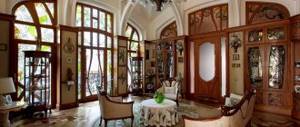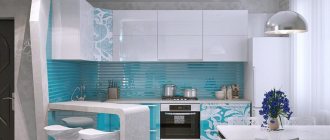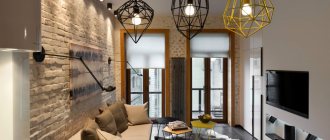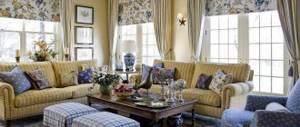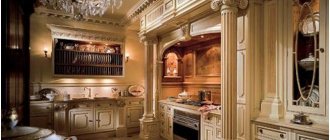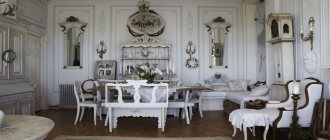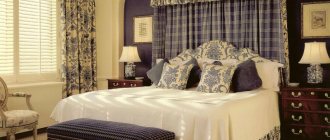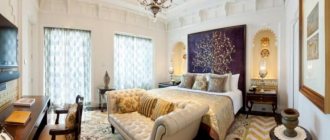Home > Architecture
Art Nouveau is an innovative architectural style of the early 20th century that originated in Europe and quickly spread throughout the world. The emergence of the style is due to three important factors: the desire to abandon traditions and rethink the past, the development of technological progress, which made it possible to create complex details, and a turning point in history that contributed to the growth of national self-awareness in European countries.
- Origin
- Characteristics
- Kinds
- Modern in Russia
- Modern in Europe
Origin
Art Nouveau originated at the turn of the 19th and 20th centuries and lasted for about thirty years. The 1890-1910s are considered to be the conventional time boundaries, but many late-style buildings were built in the 1920s.
The word "modern" translates as modern, and it was truly a new style and a real breath of fresh air in European architecture. His task was to rethink centuries-old architectural traditions using innovative methods.
The desire to renounce the old and create something completely new resonated with the mood of the society of the 1900s, which stood on the border of the old and new worlds. And just like many events that occurred at the turn of the century had a great influence on further world history, revolutionary modernism also formed a new architectural paradigm that ensured the emergence of all the main styles of the 20th century: constructivism, functionalism and modernism.
The Tassel Hotel in Brussels, designed by the architect Victor Horta, is traditionally considered the first Art Nouveau building. All details of both the exterior and interior were carefully thought out in the mansion. Here, methods were first applied that later became signature for the style: arched windows, natural stone and great attention to the interior, where mosaic floors were used, ornate staircase lattice and ornaments based on natural motifs.
From Belgium, Art Nouveau spread to the rest of Europe and then came to Russia.
Characteristics
Despite the conscious departure from the canons and significant changes in style over time, it still had its own characteristics. Typically these include asymmetry, decorative elements on plant and animal themes, colorful stained glass windows, mosaics and majolica, the use of natural materials, fluid and dynamic lines, usually made of reinforced concrete and forged metal, equal attention to both the exterior and the interior. There is often a synthesis of architecture, sculpture, painting and applied arts.
On almost every building you can see that all the elements were thought out and made in the same style: balconies, windows, doors, handles, grilles, stairs. Raw stone can coexist with bright mosaics, and sharp asymmetry with smooth lines of gratings. The new style skillfully used new technical capabilities, which made it possible to increase the number of floors in buildings and create unusual decorative elements.
Another feature of Art Nouveau is its inspiration from folk art and the Middle Ages. The beginning of the 20th century is the growth of national self-awareness and appeal to one’s cultural and historical heritage. This was expressed differently in each country. In Scandinavia, the Baltics and north-west Russia, castles are often used as inspiration, which is why many houses often resemble small castles. Hungary has a strong eastern influence. The appeal to folklore was also manifested in the use of creatures from fairy tales on the facades.
Windows and doors in Art Nouveau style
Windows and doors in the Art Nouveau style can be rectangular or arched, elongated upward or wide - like shop windows. Windows with rich plant decor or stained glass inserts will look most organic. The choice of curtains depends on the choice of wall design - the simpler the walls, the more interesting the curtains can be, and vice versa. At the same time, it is important to think about how they will look when closed and open.
Kinds
In different countries, Art Nouveau was slightly different and was even called differently: Art Nouveau in French-speaking countries, Art Nouveau and Secession in German-speaking countries. Each region brought something different to the style, but Art Nouveau also changed the most over time.
Early
Early is the most traditional and classic version of the style, when its characteristic features appeared, and architects deviated from them slightly. Also, early modernism is distinguished by the fact that it was initially used only in the construction of mansions, estates, hotels, palaces - that is, it was popular mainly among the bourgeoisie. Having learned about the new architectural fashion, many sought to stand out and build the most unusual building. Often such houses did not fit into the development, which further emphasized their non-standard nature.
Late
Over time, modernity was no longer perceived as something unusual and became more and more widespread. Now completely different buildings were built in this style: from residential complexes to industrial buildings. Entire blocks of apartment buildings in this style appeared.
His characteristic features also changed: he became more and more rational and constructive. Decorative details became fewer and fewer, the interior no longer played a big role, and a transition to functionalism became noticeable, which replaced Art Nouveau.
Wood
Wooden modernism is especially worth noting. Difficult from a technical point of view, it was quite common in Russia. Examples can be seen in St. Petersburg on Kamenny Island, Nizhny Novgorod, Yaroslavl and Vladimir regions.
Web Design / Trends
170291 07-11-2012
Art Nouveau, also known as Art Nouveau, is definitely my favorite style.
Moreover, the design of my site, by all indications, is made in the Art Nouveau style, as it turned out. This is the blue color, and floral patterns, and the richness of the composition, and the abundance of smooth lines. Art Nouveau is a very interesting style in terms of applied applications in painting, architecture, and interior decoration. It is thanks to this practical feature of extending to related areas of art that modernism has found a rebirth today. At the very least, it is very convenient to decorate your living environment in the same style, from the fence at the entrance to the cover of the book. Modern
(from the French moderne - modern) - an artistic movement in art. Representatives of Art Nouveau were united by an anti-eclectic movement - the desire to contrast their creativity with the eclecticism of the previous period. Its distinctive features are the rejection of straight lines and angles in favor of more natural, natural lines, interest in new technologies (for example, in architecture), and elements of applied art.
In different countries, the Art Nouveau style was called differently: in the USA - Tiffany (named after L. K. Tiffany), in France - Art Nouveau (French art nouveau, new art), in Germany - Art Nouveau (German Jugendstil, young style ), in Austria - Secession style (Secessionsstil), in England - modern style (modern style, modern style), in Italy - liberty style, in Spain - modernismo, in the Netherlands - Nieuwe Kunst, in Switzerland - spruce style (style sapin) .
The Modern period is relatively short and has fairly clear chronological boundaries: from the late 1880s to 1914, the beginning of the First World War, which interrupted the natural development of art in most European countries. During the Art Nouveau period, there was a rapid rethinking of old artistic forms and techniques, the rapprochement and fusion of various types and genres of art. Modern artists boldly broke the usual norms and boundaries. The main content of the Art Nouveau period was the desire to discover new methods, styles, forms, and the synthesis of various sources.
Art Nouveau artists used different forms in their work: Greek archaic, Cretan-Mycenaean art, ancient classics, exotic art of China and Japan, Gothic and Renaissance, Etruscan art and French Rococo. Ornament became one of the main expressive and style-forming means in modern art. The desire for integrity, plasticity of external and internal, decorative and structural elements of the composition, dynamics and fluidity of forms are the distinctive features of the Art Nouveau style.
Representatives of the Art Nouveau style strove for rational stylistic unity so that the paintings and tapestries adorning the walls matched the furniture, glassware, cutlery, as well as clothing, jewelry and, in general, everything that was in the space they designed. In Art Nouveau there is decorativeness and two-dimensionality of the image, the running of winding flexible lines, and planar patterns. And it didn’t matter whether such decor was intended for a book cover or for the facade of a building.
Paul Gauguin and the artists of his circle stood at the origins of French Art Nouveau. Also, the most famous master of Art Nouveau in France was Henri de Toulouse-Lautrec. An important role in the development of Art Nouveau in France was played by the architect Hector Guimard, the jeweler Rene and the glass and furniture artist Emile Galle. A significant place in Art Nouveau art belongs to the famous Belgian architects Henri van de Velde and Victor Horta. In Spain, the architect Antonio Gaudi was distinguished by the most individual and original version of Art Nouveau.
In Great Britain, features characteristic of the new style appeared in book design from the early 1880s. One of the most famous Art Nouveau graphic artists was Aubrey Beardsley, whose eccentric drawings illustrated literary works. One of the leading exponents of Art Nouveau in Britain was C. R. Mackintosh, a Scottish architect and designer who produced a variety of artistic work - from architectural designs to designs for wallpaper and silverware. Mackintosh's work had a huge influence on the development of European architecture and art.
In the USA, architect Louis Sullivan used Art Nouveau ornaments to decorate the facades of the buildings he designed. The leading representative of Art Nouveau was Louis Comfort Tiffany, a painter and glass artist. He invented a unique glass with a rainbow tint, which he called favrile and used in the manufacture of his famous vases and flower-shaped lamps.
The following artists can also be called representatives of Art Nouveau: Gustav Klimt, Alphonse Mucha, Mikhail Vrubel, Amedeo Modigliani, Henri Rousseau, Ferdinand Hodler, Jan Toorop, Anders Zorn, Konstantin Korovin, Mikhail Nesterov, Franz von Stuck, Valentin Serov, Max Kurzweil, Konstantin Somov , Alexander Benois, Mstislav Dobuzhinsky, Boris Kustodiev.
The Art Nouveau style reached its highest point of development at the turn of the 19th and 20th centuries, but was soon forgotten - leading architects now strived for simplicity and clarity of form and showed more interest in machine technology than in handmade work. The rich decor of the 1890s gave way to the geometric, unadorned surfaces of early 20th century buildings. Art Nouveau fell out of fashion and was only rediscovered fifty years later.
Modern in Russia
In Russia, when creating decor, architects turned to Russian folklore and folk tales. Traditional ornaments and scenes were often used, as well as plant decor, animals and fairy-tale creatures. The most striking representatives of the mixture of Russian style and modernism are the Kazansky railway station in Moscow and the Vitebsky railway station in St. Petersburg.
In Moscow
Of all Russian cities, it was in Moscow that Russian Art Nouveau was the most diverse and was used for the construction of completely different types of buildings: mansions, train stations, hotels and industrial enterprises. Often these are bright and extraordinary buildings that stand out among the rest of the buildings. For example, when passing by, it is impossible not to notice Pertsov’s house, not far from the Cathedral of Christ the Savior. The colorful mosaic panel and the unusual asymmetry of the roof make it look like a fairy-tale house. Also, many mansions were built in this style, which are now concentrated in the Ostozhenka Street area. The main representative of Moscow Art Nouveau is the architect Shekhtel.
In St. Petersburg
St. Petersburg has some of the best examples of modernism in Russia: the Singer House on Nevsky Prospekt, Vitebsky Station, Eliseevsky Store. In general, northern modernism, a subtype of style characterized by the use of natural materials, was more widespread here. Prominent representatives of St. Petersburg modernism are Lidval and Bobyr.
In other cities
Art Nouveau was widespread throughout Russia and found its expression in the noble mansions that can be found in Nizhny Novgorod, Samara, the Urals and Siberia.
Art Nouveau floors
Art Nouveau flooring should be quite ordinary - it could be parquet or laminate. During the reign of the Art Nouveau style, flooring was not particularly innovative. But, you can approach the design of the floor creatively and make it no less significant than the rest of the interior elements. Drawings on the floor, laid out from contrasting elements that match the color of the furniture, look very impressive. In addition, such solutions allow you to zone a room very elegantly and without unnecessary clutter.
Art Nouveau floor design options:
- parquet board laid in squares or herringbone
- artistic parquet that follows the interweaving of plants or the curve of a sea wave
- porcelain stoneware floor with figured cutting in Art Nouveau style
Modern in Europe
Art Nouveau originated in Europe, so it is not surprising that it is in European countries that it is best represented. Each country introduced its own characteristics and turned to its own national heritage and folklore.
Scandinavia and the Baltics
Finland, Sweden, Norway and Denmark turned to northern modernism, which in these countries is called national romanticism. Its spread is due to the easy availability of natural stone and wood - the main materials of the style. Impregnable houses with stone foundations and asymmetrical details often resemble Scandinavian castles - similar examples can be found in Helsinki, Oslo, Stockholm, Bergen.
Of the Baltic countries, Riga is especially worth noting, where its own “Riga Art Nouveau” appeared. Up to a third of the houses in the city center are built in this style. It is here that there is a real open-air Art Nouveau gallery - Albert Street, where the most beautiful architectural monuments of Art Nouveau are concentrated.
Western Europe
In Western Europe, Art Nouveau was more romantic and often blended quite harmoniously into the environment. Art Nouveau in Paris is, for example, the famous entrances to the metro, which have become one of the symbols of the city. The Vienna Secession in Austria was distinguished by the absence of smooth lines, it was square and strict. In Barcelona, this is the original style created by Gaudi. Smooth lines, many bright and varied decorative elements and mosaics prevailed here.
The style came to Hungary from Austria and was inherited the name “Secession”. The most examples of Hungarian secession are in Budapest, where European style mixed with Persian and Moorish motifs and became especially bright and unusual.
Art Nouveau was also popular in Prague, where the style was particularly expressive. The facades of the houses are decorated with floral ornaments and sculptures of heroes of national fairy tales. The Prague artist who worked in this style, Albert Mucha, became especially popular.
Art Nouveau ceilings
Art Nouveau is one of the few styles that should amaze with its unusual look at quite ordinary things. The ceiling should also attract attention. When decorating a ceiling in Art Nouveau style, you can use the following options:
- smooth-painted ceiling and exquisite chandelier
- smoothly painted ceiling with stucco in Art Nouveau style
- the ceiling is made of dark wood, with plaster caissons framing it
- ceiling, fully or partially decorated with stained glass
The use of gold-plated elements is also allowed - when properly combined, they can create a very stylish and luxurious atmosphere.

